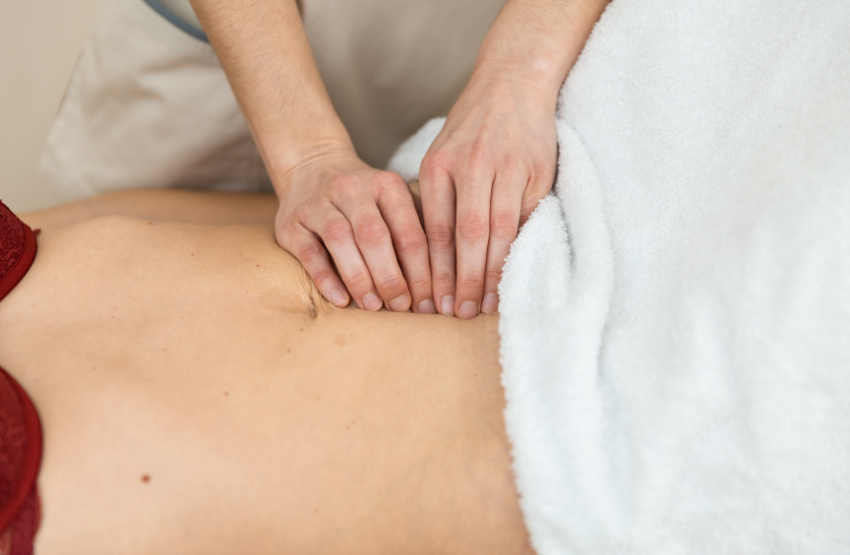Cesarean delivery is one of the most common surgical procedures worldwide, accounting for nearly one in three births in the United States¹. While lifesaving and often necessary, a C-section is major abdominal surgery, and the recovery process can be longer and more complex than that of a vaginal birth. Pain, swelling, limited mobility, and the emotional challenges of caring for a newborn while healing from surgery can leave new mothers feeling overwhelmed.
One supportive and holistic option is postpartum massage after C-section. Performed safely and at the right stage of recovery, massage can promote healing, reduce swelling, ease muscle tension, and provide emotional balance. Understanding how massage works after surgery helps new mothers make informed decisions about integrating it into their recovery plan.
Why C-Section Recovery Needs Special Care
Unlike vaginal delivery, a C-section involves an incision through the abdominal wall and uterus. This creates additional layers of trauma that the body must repair, leaving many women with tenderness, scar tissue formation, and a longer healing window. Postoperative swelling is common, often made worse by IV fluids administered during labor and surgery. Limited mobility during the early weeks can also contribute to stiffness and discomfort.
The emotional aspects of C-section recovery deserve equal attention. Many women feel frustrated by activity restrictions or anxious about their ability to care for their baby while healing.
This combination of physical and emotional strain highlights the need for gentle, restorative approaches that can support the healing process in multiple ways.
Massage for Scar Tissue Healing
One of the primary benefits of postpartum massage after a C-section is its effect on scar tissue. Once the incision has closed and a healthcare provider has cleared the mother for massage, often around six to eight weeks postpartum, gentle massage around the scar can be introduced.
Research suggests that scar mobilization techniques (like cross-fiber friction) help improve circulation, which in turn supports collagen remodeling and more flexible scar tissue². This reduces the likelihood of adhesions, which are bands of tissue that can limit mobility and cause ongoing discomfort.
Scar massage can also decrease hypersensitivity or numbness around the incision site. Many women report improved body awareness and comfort as the area begins to feel less rigid. Over time, consistent massage may contribute to a softer, flatter scar that not only feels better but also supports better range of motion in the abdominal area.
Lymphatic Drainage and Swelling Reduction
Swelling, or edema, is another common issue following a C-section. The combination of surgical trauma, fluid retention from IVs, and reduced mobility often leads to puffiness in the abdomen, legs, and feet. Lymphatic drainage massage, a gentle technique that encourages the movement of lymph fluid, has been shown to help reduce swelling and support immune function³.
By stimulating lymphatic flow, massage can relieve the heavy, uncomfortable sensation associated with edema. Improved circulation also helps deliver nutrients and oxygen to healing tissues, which may accelerate recovery. For many new mothers, the relief of reduced swelling translates to greater comfort in daily activities, from walking to holding their baby.
Supporting Lactation and Upper Body Comfort
C-section recovery is not limited to the surgical site. New mothers also experience significant upper-body strain from the physical demands of feeding, holding, and soothing their newborn. Hours spent nursing can lead to tension in the shoulders, neck, and upper back, sometimes contributing to headaches or arm discomfort.
Massage helps release this muscular tightness, restoring mobility and improving circulation in areas under constant strain⁴. Relaxation from massage may also indirectly support lactation.
Elevated stress levels and tension can interfere with milk let-down, while relaxation techniques (including massage) have been shown to promote oxytocin release, a hormone that plays a role in both bonding and milk flow⁵.
By easing muscular and emotional stress, postpartum massage offers mothers greater comfort during feeding and care routines.
Postpartum Massage Benefits Beyond the Physical
The advantages of postpartum massage extend well beyond physical recovery. Research indicates that massage therapy can lower cortisol, the body’s primary stress hormone, while boosting serotonin and dopamine, which enhance mood and relaxation³. These effects are particularly valuable in the postpartum period, when mothers may face heightened vulnerability to mood fluctuations and symptoms of postpartum depression.
Massage also provides a unique opportunity for new mothers to receive nurturing care at a time when the focus is often on the baby. The quiet space of a massage session can foster mindfulness, improve sleep, and restore emotional balance, which in turn supports both maternal and infant well-being.
Safety Considerations for C-Section Massage
As with all postpartum care, safety comes first. Women should seek clearance from their healthcare provider before beginning massage, especially after a surgical delivery. Timing varies, but many providers recommend waiting six to eight weeks to allow the incision to heal sufficiently. Once approved, therapists can start with gentle techniques away from the scar before gradually incorporating direct scar tissue work.
It is essential to work only with licensed massage therapists who are trained in postpartum care. These practitioners understand safe techniques for lymphatic drainage, scar mobilization, and positioning that protects the healing abdomen. Sessions are typically performed with the mother lying on her side or back, supported with cushions for comfort. Clear communication with the therapist about any discomfort ensures that treatment remains gentle and supportive.
C-Section Recovery vs. General Postpartum Massage
Although all postpartum massage shares the goal of supporting new mothers, the needs of those recovering from a C-section are more specialized. General postpartum massage focuses on easing muscle tension, promoting circulation, and supporting emotional well-being. Post C-section massage incorporates these same benefits but adds scar tissue mobilization, lymphatic drainage, and abdominal support once clearance is given.
This distinction can be summarized as follows:
- General postpartum massage addresses overall stress, muscle strain, and circulation.
- Post-C-section massage goes further, supporting incision healing, swelling reduction, and abdominal recovery.
By tailoring massage techniques to the type of birth and the stage of healing, therapists can provide care that truly meets the mother’s individual needs.
Conclusion
Recovering from a C-section requires time, patience, and comprehensive support. While rest, medical care, and proper nutrition are essential, massage offers an additional pathway to healing. Postpartum massage after C-section can reduce swelling, promote scar healing, ease muscular strain, and restore emotional balance. With guidance from healthcare providers and treatment from licensed therapists trained in postpartum care, massage becomes not only a source of comfort but also an important tool for long-term recovery.
For new mothers navigating the challenges of surgical recovery while caring for their baby, massage provides a reminder that their own healing matters. By integrating massage into a postpartum care plan, mothers can move through recovery with greater ease, resilience, and well-being.
References
- Centers for Disease Control and Prevention. Births: Provisional Data for 2022. Retrieved from https://www.cdc.gov/nchs/nvss/births.htm
- Verywell Health. C-Section Scar Massage: Benefits, Techniques, and Safety. Retrieved from https://www.verywellhealth.com/c-section-scar-massage-5209298
- Field, T. (2021). Postpartum Massage Therapy Research: A Review. International Journal of Environmental Research and Public Health, 18(15), 7877. Available on PubMed Central: https://www.ncbi.nlm.nih.gov/pmc/articles/PMC8396946/
- Cleveland Clinic. Postpartum Massage: Benefits and What to Expect. Retrieved from https://health.clevelandclinic.org/postpartum-massage
- Mayo Clinic. Breastfeeding nutrition: Tips for moms. Retrieved from https://www.mayoclinic.org/healthy-lifestyle/infant-and-toddler-health/in-depth/breastfeeding-nutrition/art-20046912


